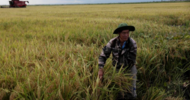
The oil palm industry’s rapid growth in West Papua is having serious adverse effects on its indigenous population.
West Papua Oil Palm Atlas: The companies behind the plantation explosion
During the last few decades, Indonesia’s oil palm industry has been growing rapidly, but with the vast majority of this expansion on the islands of Borneo and Sumatra. With large tracts of land increasingly difficult to find in those regions, plantation companies are now shifting their attention to the Maluku archipelago and especially to conflict-ridden West Papua. While in 2005 there were only five oil palm plantation companies operating in West Papua, by the end of 2014 there were already 21 operational plantations. This rapid expansion is set to continue with many more companies having already obtained an initial location permit. If all these plantations were to be developed, more than 2.6 million hectares of land would be used up, the vast majority of which is currently tropical forest and the home of many indigenous peoples groups. AwasMIFEE, Pusaka and six other organisations recently published “The West Papua Oil Palm Atlas” in an attempt to break the isolation of this region, in a context where communities choosing to oppose plantation companies often feel intimidated by state security forces that back up the companies.
The oil palm industry’s rapid growth in West Papua is having serious adverse effects on its indigenous population. For almost every single existing plantation, there have been reports that indigenous peoples have lost out when the forests they depend on for their livelihoods become oil palm plantations. Besides, almost without exception, these plantations have caused conflicts with and within indigenous communities who depend on the forest – most lowland Papuans are hunters and gatherers to some degree. The conflicts have centred around communities' refusal to hand over their land, demand for justice in the cases where they feel the land has been taken from them by deceit or intimidation, horizontal conflicts between neighbouring villages or clans, action by indigenous workers who feel they are being exploited, or aggression by police or military working as security guards for the plantation companies.
Although Indonesian law does recognise communal land rights for indigenous communities with customary use of the land, in reality, those communities often face considerable pressure to give up that land. When affected communities do get some compensation, they rarely get more than US$30 per hectare, with some cases of compensation of as little as US$3 per hectare reported. This pressure is further fuelled by the fact that local administrations and companies are often reluctant to share information about permits, meaning that communities often know nothing of the plantation plans until a company shows up trying to acquire their land.
Who are the companies involved this expansion?
The many companies controlling the oil palm industry in Papua often use local names, or names which give the impression of being pro-people and pro-environment. In reality, they are often controlled by members of the business elite and part of large corporate groups working with multinational companies. Typically, these companies also have businesses in other sectors, such as logging, industrial tree plantations, mining or industrial-scale fishing, both in Papua and in other parts of Indonesia.
Some of these corporate groups are linked to some of Indonesia’s richest business entities according to Forbes (2014) data, including the Raja Garuda Mas group, the Sinar Mas group, the Salim group and the Rajawali group. Most of them have more than one concession for oil palm plantations, and some have other businesses, like the Rajawali group which is also developing sugar-cane plantations in the Merauke area. Other major companies involved are the Austindo Nusantara Jaya Group, which is also developing the Sago Palm processing industry in the Metamani area of South Sorong and an electricity plant in Tembagapura, Mimika; the Kayu Lapis Indonesia Group, which has its roots in logging, and is the largest operator of timber concessions in Papua; the Medco Group, which is also active in industrial timber plantations, pulp and mining around Papua; and the Korindo Group, which is using the timber extracted from the land for oil palm plantations for its plywood business. Moreover, other foreign companies operating in Papua are the Tadmax group from Malaysia, Pacific Interlink from Yemen, the Genting Group from Malaysia, the Noble Group from Hong Kong, and the Carson Cumberbatch from Sri Lanka. In contrast with other parts of Indonesia, only one oil palm plantation is operated by a state company: PTPN II in Arso.
Apart from these big national and transnational companies, the West Papua Oil Palm Atlas also shows that there are several other “mysterious” companies that pioneer new investments, profiting from their links with local governments to obtain permits for the plantations. These companies operate very discreetly and try to avoid having any kind of public profile. They don’t have websites, their offices in Jakarta have no company names and refuse to give out any information. These companies include the Menara Group, which obtained permits for seven subsidiaries before selling most of them, and PT Pusaka Agro Sejahtera Group, which also managed to receive plantation permits. There are indications that the main interest of this kind of companies is speculative - once all the permits have been obtained, the plantation company would then be sold on to another company, very likely to one of the big national or transnational companies that have bigger access to capital. This type of shady behind-closed-doors business practice however, makes it further impossible for indigenous communities to gain respect their rights as responsibilities shift with the sale of the companies that originally obtained the permit while the new owners often reject responsibilities for unpaid compensation etc.
Below are two of the many sections from the Atlas that portray concrete examples of what is going on in the region:
“Timber companies see the future lies in oil palm”
In 2003, the Kayu Lapis Indonesia Group was the biggest logging company in Papua, operating 1.4 million hectares of concessions. One of their largest concessions was in Sorong, PT Intimpura, where it also owned a huge wood factory producing 264,000 cubic metres of plywood per year. But like several other timber companies, the Group opted to shift its investment into the expanding oil palm industry a few years before its forest management permit was due to run out in 2009. Using its links with the local government, it managed to obtain permits for five subsidiary companies in the next few years to start oil palm plantations. Currently, two of these subsidiaries are operational. PT Henrison Inti Persada (HIP) in Klamono is the most advanced, having received the final permit in 2006 - although it had already started planting oil palm illegally a few years before.
PT HIP established its plantation on the land of the Mooi people through trickery and by making promises to provide new facilities or education support that have not yet materialised. The compensation given to communities was exceptionally low, even compared to other cases around Papua. In one documented case, ancestral land was handed over for 30 000 Rupiah per hectare (around US$3). In 2010, PT HIP was sold to the Noble Group, a Hong Kong-based agricultural commodities trading company. Noble became a member of the Round Table on Sustainable Oil Palm which allows it to apply for sustainability certification that facilitates access to premium markets. As the new owner, Noble cannot be held responsible for the illegal logging and land-grabbing that took place when PT HIP was owned by the Kayu Lapis Indonesia Group. As a consequence, Noble can present itself with a “respectable image” despite all the destruction and harm to local communities.
“Oil and gas below ground, palm oil above ground”
Bintuni Bay is the centre of oil and gas development in West Papua, with UK-company BP, Malaysian-company Genting Oil and Italian-company Eni Oil extracting or exploring reserves. Designated by the government as a key area for energy and industrial development in Papua, Ferrostaal from Germany and LG from Korea, together with local partners, both want to develop ethanol plants, and the Indonesian state-owned fertilizer company PT Pupuk Indonesia is also lining up to invest. Once covered with rainforest and mangrove forest, Bintuni Bay is in the process of being turned into an industrial landscape, with industrial oil palm plantations as a key part of the picture, since nowadays oil can also be extracted from trees.
PT Varita Majutama – now owned by the Malaysian company Genting Berhad – was the first to arrive in the area in 1996, developing three blocks of 6,460, 5,510 and 5,300 hectares respectively. The company confronted conflicts with the local populations since the beginning. In 2007 and 2012 some of the affected communities around Tofoi blockaded the plantations as the company continued to ignore their demands. The company nevertheless continued to expand. In January 2013, another 35,371 hectares of land were released by the Forestry Ministry to be planted with oil palm. The indigenous peoples around Tofoi also have to contend with two oil companies operating on their land, Genting Oil and Eni Oil, which bring further problems, including an increased police and military presence. In 2012 for example, the Kamisopa and Sodefa clans disputed the boundaries of land, until a fight broke out. Police brought criminal accusations against one man, and then forced his brother to sign a document handing over rights to their ancestral land to Genting Oil – threatening that if he didn’t, his younger brother would face five years in prison.
The West Papua Oil Palm Atlas is an important warning of the growing expansion of these plantations as well as a clear picture of who are the actors benefiting from this boost. Using the excuse of the conflict around the independence movement, the Indonesian government makes it very difficult for international observers to access this region. This has probably added to the lack of awareness internationally about the threats towards forests and the populations in West Papua that depend on them for their livelihoods. With sound research and detailed maps for each area of the Papua region which confronts different and manifold threats from the extractivist and industrialization model, the Atlas can also be seen as a call-out to stand in solidarity with the many communities confronting this industry.
Selwyn Moran, awasMIFEE, [email protected]
Y.L. Franky, Pusaka, [email protected]
Access the West Palm Oil Palm Atlas in English here:
https://awasmifee.potager.org/uploads/2015/04/atlas-sawit-en.pdf
And in Bahasa-Indonesia:
http://awasmifee.potager.org/uploads/2015/04/atlas-low-resolution-Final-id.pdf












